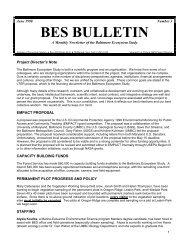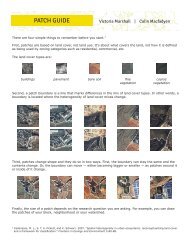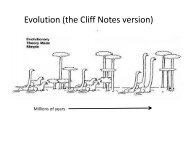Investigations in Urban Soils - Baltimore Ecosystem Study
Investigations in Urban Soils - Baltimore Ecosystem Study
Investigations in Urban Soils - Baltimore Ecosystem Study
Create successful ePaper yourself
Turn your PDF publications into a flip-book with our unique Google optimized e-Paper software.
Draft 2 - (9.28.04)<br />
<strong>Soils</strong> <strong>Urban</strong> <strong>in</strong> <strong>Investigations</strong><br />
Background: What is Soil and Why is it Important?<br />
Def<strong>in</strong>ition<br />
What is soil? Technical def<strong>in</strong>itions abound (see references) but simply stated,<br />
soil is the natural mixture of liv<strong>in</strong>g and nonliv<strong>in</strong>g th<strong>in</strong>gs at the earth’s surface. Soil<br />
conta<strong>in</strong>s air, water, m<strong>in</strong>erals, organic material (matter that was once liv<strong>in</strong>g), and liv<strong>in</strong>g<br />
organisms <strong>in</strong> a comb<strong>in</strong>ation that supports the growth of plants. Dirt, by comparison, is<br />
what you f<strong>in</strong>d underneath your f<strong>in</strong>gernails: it conta<strong>in</strong>s little liv<strong>in</strong>g material and does not<br />
support plant growth. Soil is not dirt!<br />
Please note that terms below are used <strong>in</strong> the context of soil science, and may be<br />
used differently <strong>in</strong> other discipl<strong>in</strong>es.<br />
Soil Formation<br />
There are five widely recognized factors that affect the formation of soil. We also<br />
consider a sixth factor, human activity. Putt<strong>in</strong>g them all together, we can say that soil is<br />
formed by the comb<strong>in</strong>ed effects of (1) climate, (2) organisms, and (3) humans, modified<br />
by (4) slope, act<strong>in</strong>g on (5) parent material over (6) time. To expla<strong>in</strong>:<br />
1) Precipitation and temperature <strong>in</strong>fluence soil formation.<br />
2) Organisms add organic matter to the soil surface and other organisms<br />
decompose and mix organic matter <strong>in</strong>to the soil.<br />
3) Humans move and manage soil <strong>in</strong> many ways, with various consequences.<br />
4) The slope, or topography, determ<strong>in</strong>es such th<strong>in</strong>gs as the amount of ra<strong>in</strong><br />
<strong>in</strong>filtration and soil thickness.<br />
5) The parent material may be the orig<strong>in</strong>al bedrock that has been eroded by<br />
many years of weather<strong>in</strong>g, or may have been sediment deposited on the<br />
bedrock by movements of w<strong>in</strong>d, water, or ice (Figure 1). As a result of<br />
weather<strong>in</strong>g processes and the <strong>in</strong>put of organic matter at the soil surface,<br />
horizons will form over many years (Figure 1).<br />
6) Soil formation <strong>in</strong> nature takes a lot of time because the physical and chemical<br />
processes that are <strong>in</strong>volved are very slow. It takes thousands of years of to<br />
develop the ideal soil for a specific k<strong>in</strong>d of plant. The slow work of natural<br />
processes can be undone by humans <strong>in</strong> a matter of weeks.<br />
Because different places on the Earth have a different set of soil form<strong>in</strong>g factors,<br />
soils vary a lot <strong>in</strong> fertility and their suitability for grow<strong>in</strong>g different k<strong>in</strong>ds of plants. Many<br />
plants can adapt and thrive <strong>in</strong> even very poor soils.<br />
Soil Structure<br />
Soil structure is def<strong>in</strong>ed as: soil particles arranged <strong>in</strong> the profile <strong>in</strong> such a manner<br />
as to give a dist<strong>in</strong>ctive, characteristic pattern. Soil has two solid components: m<strong>in</strong>eral<br />
particles and organic material. Soil m<strong>in</strong>eral particles are sand, silt, and clay. Sand is<br />
the largest of the three particles and clay the smallest. Soil texture refers to the particle<br />
size and the relative proportions of sand, silt, and clay <strong>in</strong> a soil. <strong>Soils</strong> may be described<br />
as sandy or loamy, for example – the texture is different for every soil (Figure 2).<br />
Organic material <strong>in</strong> soil is liv<strong>in</strong>g and non-liv<strong>in</strong>g. Soil is teem<strong>in</strong>g with microorganisms<br />
page 2<br />
<strong>Baltimore</strong> <strong>Ecosystem</strong> <strong>Study</strong><br />
– <strong>Investigations</strong> <strong>in</strong> <strong>Urban</strong> <strong>Soils</strong>






